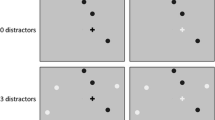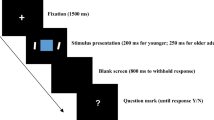Abstract
Aging is associated with declines in attention, but also with a tendency to attend to emotionally positive information. When attention is engaged in an ongoing task, an unexpected stimulus may not be detected, resulting in inattentional blindness. Inattentional blindness increases in older age, due to reduced attentional capacity. In the present study, age differences in inattentional blindness to emotional unexpected stimulus were investigated. Younger and older adults completed an inattentional blindness task in which a positive and a negative unexpected stimulus appeared concurrently while attention was engaged in a counting task. Overall, the findings replicated previous results showing greater inattentional blindness for older adults. While both groups were more likely to detect the positive stimulus, this tendency was stronger in older adults. The participants who detected only the positive stimulus were more likely to be the older ones. There were no group differences in the detection of the negative stimulus. The results are partially consistent with age-related positivity effect, demonstrating that older adults’ positive mood affects their attentional filter. The results emphasize the role of emotional and motivational changes in older age and show that higher inattentional blindness for older adults cannot solely be explained by reductions in attentional capacity.


Similar content being viewed by others
Availability of Data
The data file generated and analysed during the current study are available in OSF repository, [https://osf.io/vc8qz/?view_only=3e1c874fe08842db8e5caf34f0127c02].
Code Availability
The displays that were used in the current study can be viewed in OSF repository, [https://osf.io/vc8qz/?view_only=3e1c874fe08842db8e5caf34f0127c02].
Notes
Eighty-five younger adults (53 females, 18-37 years old, M = 29.09, SD = 3.254) and 26 older adults (19 females, 60-79 years old, M = 65.67, SD = 4.73) participated in the pilot study.
Note that the four younger participants who detected both the negative and the positive US can be included in the group who detected the negative US (and of course in the group who detected the positive US). If we include those four participants in the group who detected the negative US, Fisher’s exact test showed that the difference between the younger and older adults reaches significance, p < .05, ɸ = .33.
References
Akça-Kalem, Ş. Ö. (2002). Kısa Blessed oryantasyon-bellekkonsantrasyon testi (BOMC) ve standardize mini mental test (SMMT) betimsel istatistik değerlerinin bir normal erişkin Türk örnekleminde saptanması. Nöropsikiyatri Arşivi, 39, 95–102.
Beck, A. T., Ward, C. H., Mendelson, M., Mock, J., & Erbaugh, J. (1961). An inventory for measuring depression. Archives of General Psychiatry, 4(6), 561–571. https://doi.org/10.1001/archpsyc.1961.01710120031004
Becker, M. W., & Leinenger, M. (2011). Attentional selection is biased toward mood-congruent stimuli. Emotion, 11(5), 1248–1254. https://doi.org/10.1037/a0023524
Blessed, G., Tomlinson, B. E., & Roth, M. (1968). The association between quantitative measures of dementia and of senile change in the cerebral grey matter of elderly subjects. The British Journal of Psychiatry., 114(512), 797–811. https://doi.org/10.1192/bjp.114.512.797
Brink, T. L., Yesavage, J. A., Lum, O., Heersema, P. H., Adey, M., & Rose, T. L. (1982). Screening tests for geriatric depression. Clinical Gerontologist, 1(1), 37–43. https://doi.org/10.1300/J018v01n01_06
Carstensen, L. L. (1992). Social and emotional patterns in adulthood: Support for socioemotional selectivity theory. Psychology and Aging, 7(3), 331–338. https://doi.org/10.1037//0882-7974.7.3.331
Carstensen, L. L., Pasupathi, M., Mayr, U., & Nesselroade, J. R. (2000). Emotional experience in everyday life across the adult life span. Journal of Personality and Social Psychology, 79(4), 644–655. https://doi.org/10.1037/0022-3514.79.4.644
Craik, F. I., & Byrd, M. (1982). Aging and cognitive deficits. In Aging and cognitive processes (pp. 191–211). Springer.
Ertan, T., & Eker, E. (2000). Reliability, validity, and factor structure of the geriatric depression scale in Turkish elderly: Are there different factor structures for different cultures? International Psychogeriatrics, 12(2), 163–172. https://doi.org/10.1017/S1041610200006293
Fockert, J. W., & Bremner, A. J. (2011). Release of inattentional blindness by high working memory load: Elucidating the relationship between working memory and selective attention. Cognition, 121(3), 400–408. https://doi.org/10.1016/j.cognition.2011.08.016
Ford, J. H., DiBiase, H. D., Ryu, E., & Kensinger, E. A. (2018). It gets better with time: Enhancement of age-related positivity effect in the six months following a highly negative public event. Psychology and Aging, 33(3), 419–424. https://doi.org/10.1037/pag0000250
Gençöz, T. (2000). Positive and negative affect schedule: A study of validity and reliability. Türk Psikoloji Dergisi, 19–28
Graham, E. R., & Burke, D. M. (2011). Aging increases Inattentional blindness to the Gorilla in our midst. Psychology and Aging, 26(1), 162–166. https://doi.org/10.1037/a0020647
Gross, J., Carstensen, L. L., Pasupathi, M., Tsai, J., Skorpen, C. G., & Hsu, A. Y. (1997). Emotion and aging: Experience, expression, and control. Psychology and Aging, 12(4), 590–599. https://doi.org/10.1037//0882-7974.12.4.590
Hasher, L., & Zacks, R. T. (1988). Working memory, comprehension, and aging: A review and a new view. Psychology of Learning and Motivation, 22, 193–225. https://doi.org/10.1016/S0079-7421(08)60041-9
Hisli, N. (1989). Beck Depresyon Envanterinin üniversite öğrencileri için geçerliği, güvenirliği. (a reliability and validity study of Beck depression inventory in a university student sample). Psikoloji Dergisi, 7, 3–13.
Horwood, S., & Beanland, V. (2016). Inattentional blindness in older adults: Effects of attentional set and to-be-ignored distractors. Attention, Perception, & Psychophysics, 78(3), 818–828. https://doi.org/10.3758/s13414-015-1057-4
Kahneman, D. (1973). Attention and effort. Prentice-Hall.
Katzman, R. B. (1983). Validation of a short orientation-memory-concentration test of cognitive impairment. American Journal of Psychiatry, 140, 734–739. https://doi.org/10.1176/ajp.140.6.734
Labouvie-Vief, G. (2003). Dynamic integration: Affect, cognition, and the self in adulthood. Current Directions in Psychological Science, 12, 201–206. https://doi.org/10.1046/j.0963-7214.2003.01262.x
Lee, H.-J., & Telch, M. J. (2008). Attentional biases in social anxiety: An investigation using the inattentional blindness paradigm. Behaviour Research and Therapy, 46, 819–835. https://doi.org/10.1016/j.brat.2008.04.001
Liu, H. H. (2018). Age-Related effects of stimulus type and congruency on inattentional blindness. Frontiers in Psychology, 9. https://doi.org/10.3389/fpsyg.2018.00794
Lustig, C., Hasher, L., & Zacks, R. (2007). Inhibitory deficit theory: Recent developments in a “new view”. Inhibition in cognition, 17, 145–162. https://doi.org/10.1037/11587-008
Mack, A., & Rock, I. (1998). Inattentional Blindness. MIT Press.
Mack, A., Pappas, Z., Silverman, M., & Gay, R. (2002). What we see: Inattention and the capture of attention by meaning. Consciousness and Cognition, 11, 488–506. https://doi.org/10.1016/s1053-8100(02)00028-4
Mather, M., & Carstensen, L. L. (2003). Aging and attentional biases for emotional faces. Psychological Science, 14(5), 409–415. https://doi.org/10.1111/1467-9280.01455
Mather, M., & Carstensen, L. L. (2005). Aging and motivated cognition: The positivity effect in attention and memory. Trends in Cognitive Sciences, 9(10), 496–502. https://doi.org/10.1016/j.tics.2005.08.005
Most, S. B., Scholl, B. J., Clifford, E. R., & Simons, D. J. (2005). What you see is what you set: Sustained inattentional blindness and the capture of awareness. Psychological Review, 112(1), 217–242. https://doi.org/10.1037/0033-295x.112.1.217
Nasreddine, Z. S., Phillips, N. A., Bédirian, V., Charbonneau, S., Collin, I., Cummings, J.L., & Chertkow, H. (2005). The Montreal cognitive assessment, MoCA: a brief screening tool for mild cognitive impairment. Journal of the American Geriatrics Society, 53(4), 695–699. https://doi.org/10.1111/j.1532-5415.2005.53221.x
Neisser, U., & Becklen, R. (1979). Selective looking: Attending to visually specified events. Cognitive Psychology, 7(4), 480–494. https://doi.org/10.3758/BF03198284
Özdilek, B., & Kenangil, G. (2014). Validation of the Turkish version of the Montreal cognitive assessment scale (MoCA-TR) in patients with Parkinson’s disease. The Clinical Neuropsychologist, 28(2), 333–343. https://doi.org/10.1080/13854046.2014.881554
Parks, S. L., & Dollinger, S. C. (2014). He positivity effect and auditory recognition memory for musical excerpts in young, middle-aged, and older adults. Psychomusicology: Music, Mind, and Brain, 24(4), 298–308. https://doi.org/10.1037/pmu0000079
Redlich, D., Memmert, D., & Kreitz, C. (2021). Clarifying the effect of facial emotional expression on inattentional blindness. Consciousness and Cognition, 87, 103050. https://doi.org/10.1016/j.concog.2020.103050
Simons, D. J., & Chabris, C. F. (1999). Gorillas in our midst: Sustained inattentional blindness for dynamic events. Perception, 28(9), 1059–1074. https://doi.org/10.1068/p281059
Simons, D. J., & Jensen, M. S. (2009). The effects of individual differences and task difficulty on inattentional blindness. Psychonomic Bulletin & Review, 16(2), 398–403. https://doi.org/10.3758/PBR.16.2.398
Stothart, C. R., Boot, W. R., & Simons, D. J. (2015). Using mechanical Turk to assess the effects of age and spatial proximity on Inattentional blindness. Collabra: Psychology, 1(1), 1–7. https://doi.org/10.1525/collabra.26
Watson, D., Clark, L. A., & Tellegen, A. (1988). Development and validation of brief measures of positive and negative affect: The PANAS scales. Journal of Personality and Social Psychology, 54(6), 1063–1070. https://doi.org/10.1037/0022-3514.54.6.1063
Wei, X., Zhang, H., Hu, J., Xu, J., & Wang, J. (2021). The effect of emotional valence and age of faces on adults and children’s inattentional blindness. Attention, Perception, & Psychophysics, 83, 1571–1580. https://doi.org/10.3758/s13414-020-02221-w
Ziaei, M., Salami, A., & Persson, J. (2017). Age-related alterations in functional connectivity patterns during working memory encoding of emotional items. Neuropsychologia, 1–12. https://doi.org/10.1016/j.neuropsychologia.2016.11.012
Acknowledgments
We would like to thank Aysu Mutlutürk for her comments about the data analysis and Işıl Şanusoğlu for collecting part of the data. Special thanks are extended to the participants who dedicated their time to this project.
Funding
The authors have no funding to disclose.
Author information
Authors and Affiliations
Contributions
Both authors contributed equally to the conceptualization, the design of the study and the analyses of the data, as well as to the interpretation of the results and to manuscript preparation.
Corresponding author
Ethics declarations
All procedures performed in studies involving human participants were in accordance with the ethical standards of the institutional research committee and with the 1964 Helsinki Declaration and its later amendments or comparable ethical standards.
Informed Consent
Informed consent was obtained from all individual adult participants included in the study.
Conflict of Interest
The authors declare that they have no conflict of interest.
Additional information
Publisher’s Note
Springer Nature remains neutral with regard to jurisdictional claims in published maps and institutional affiliations.
Rights and permissions
About this article
Cite this article
Tunç, R., Ikier, S. Age differences in Inattentional blindness to emotional stimulus. Curr Psychol 42, 8327–8334 (2023). https://doi.org/10.1007/s12144-021-02159-8
Accepted:
Published:
Issue Date:
DOI: https://doi.org/10.1007/s12144-021-02159-8




